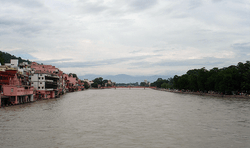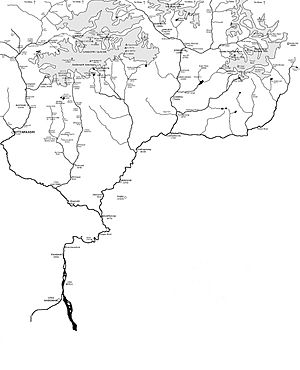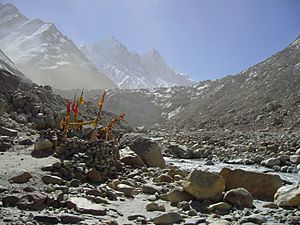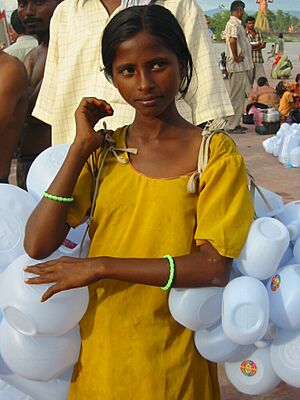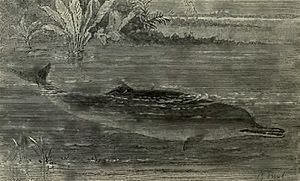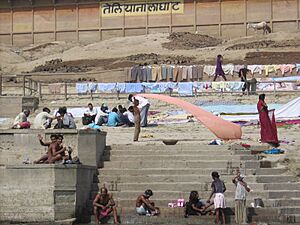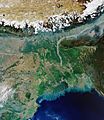Ganges facts for kids
Quick facts for kids Ganges |
|
| River | |
|
The Ganges in Haridwar
|
|
| Countries | India, Bangladesh |
|---|---|
| States | Uttarakhand, Uttar Pradesh, Bihar, Jharkhand, West Bengal |
| Tributaries | |
| - left | Mahakhali, Karnali, Koshi, Gandak, Ghaghra |
| - right | Yamuna, Son, Mahananda |
| Cities | Haridwar, Kanpur, Allahabad, Varanasi, Ghazipur, Patna, Kolkata |
| Source | Gangotri Glacier |
| - location | Uttarakhand, India |
| - elevation | 3,892 m (12,769 ft) |
| - coordinates | 30°59′N 78°55′E / 30.983°N 78.917°E |
| Mouth | Ganges Delta |
| - location | Bay of Bengal, Bangladesh & India |
| - elevation | 0 m (0 ft) |
| - coordinates | 22°05′N 90°50′E / 22.083°N 90.833°E |
| Length | 2,510 km (1,560 mi) |
| Basin | 907,000 km² (350,195 sq mi) |
| Discharge | mouth |
| - average | 12,015 m³/s (424,306 cu ft/s) |
The Ganges is a very important river in India and Bangladesh. It is the second largest river on the Indian subcontinent by how much water it carries. The Ganges River is named after Ganga, a Hindu goddess. Many people, from geographers to historians, see the Ganges as the heart of Indian culture and life.
Contents
Geography of the Ganges River
The Ganges River flows through many important cities in India. Some of these cities include Patliputra, Allahabad, and Kolkata. The area that the Ganges River drains is called its basin. This basin covers about 1,000,000 square kilometers (390,000 sq mi). It is home to one of the largest populations of people in the world. The river is about 17 meters (52 feet) deep on average, and can be as deep as 33 meters (100 feet).
The Course of the Ganges River
The Ganges River starts high in the Himalayas from a glacier called Gangotri Glacier. It flows through northern India and eventually reaches the Bay of Bengal in eastern India. The river travels about 3,877 kilometers (2,409 miles) in total, making it one of the world's longest rivers. Its basin covers a huge area of 907,000 square kilometers (350,000 sq mi).
The Ganges flows only about 200 kilometers (124 miles) through the Himalayas. It then reaches flat land near Haridwar in Uttarakhand. After that, it passes through cities like Kanpur, Allahabad, and Varanasi. In Allahabad, the Ganges joins with the Yamuna River.
Near the border with Bangladesh, the river splits into two main parts. One part is called the Bhāgirathi-Hooghly, which later forms the Hooghly River. The main part of the Ganges then flows into Bangladesh. A large structure called the Farakka Barrage helps control the river's flow. It sends some water into a canal that connects to the Hooghly River. This helps keep the Hooghly River from getting too much silt.
History of the Ganges River
In ancient times, during the early Vedic period, the Indus River was more important than the Ganges. However, later Hindu texts show that the Ganges became much more significant.
One of the first Europeans to write about the Ganges was Megasthenes, who visited India around 300 BCE. Later, in Rome, a famous fountain called the Fontana dei Quattro Fiumi was built in 1651. It features four large rivers that represent the four known continents at that time. The Ganges is one of these rivers, showing its global importance.
Religious Importance of the Ganges
The Ganges in Hinduism
For Hindus, the Ganges is more than just a river. It is seen as a mother, a goddess, and a symbol of culture and tradition. Many Hindus believe that taking a dip in the Ganges can wash away their past sins. Some also believe it can help cure illnesses. Because of this, many Hindu families keep Ganges water in their homes, believing it is very pure.
Holy towns like Haridwar, Allahabad, and Varanasi are located along the Ganges. Thousands of Hindu pilgrims visit these towns every year to bathe in the river.
The Legend of Bhagirath
According to Hindu stories, a king named Bhagiratha prayed for many years to bring the Ganges River to Earth. At that time, the Ganges was in the heavens. King Bhagiratha wanted the pure waters of the Ganges to free his ancestors from a curse. So, the Ganges came down to Earth to make the land holy and fertile, and to cleanse people's sins.
Irrigation and Water Use
The Ganges and its smaller rivers, especially the Yamuna, have been used for watering crops for a very long time. Dams and canals were used in the Ganges plains as early as the fourth century BCE. The Ganges basin has a huge potential for making electricity from water. About half of this potential could be used easily.
Canals for Irrigation
Ancient writings from the third century BCE describe canals in the Ganges plain. Later, rulers like Firuz Shah Tughlaq built many canals. One of the longest, about 240 kilometers (149 miles), was built in 1356 on the Yamuna River. This is now known as the Western Yamuna Canal.
The Mughal emperor Shah Jahan also built an irrigation canal on the Yamuna River in the early 1600s. This canal was later reopened by the British in 1830 as the Eastern Yamuna Canal. It became a model for future canal projects.
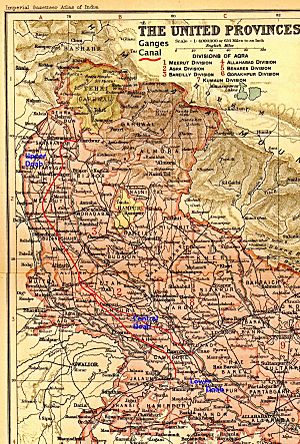
The first major British canal in India was the Ganges Canal, built between 1842 and 1854. This project was very important, especially after a severe famine in 1837–38. The canal was designed to bring water to dry areas. It was a massive project, costing about £2.15 million. The Ganges Canal was officially opened in 1854. It was considered the largest canal ever attempted in the world at that time.
Dams and Barrages
A large barrage (a type of low dam) was opened at Farakka in 1975. It is near where the main river flows into Bangladesh. This barrage helps control the water flow to the Hooghly River. How the water is managed here has caused some disagreements between India and Bangladesh. However, a treaty signed in 1996 helped solve some of these issues.
The Tehri Dam was built on the Bhagirathi River, which is a tributary of the Ganges. This dam is located near where the Bhilangana River meets the Bhagirathi. The Bhagirathi River becomes the Ganges after Devprayag. Building this dam in an area prone to earthquakes was a debated topic.
The Bansagar Dam was built on the Son River, another tributary of the Ganges. This dam is used for both irrigation and making hydroelectric power.
Economy and Tourism
The Ganges Basin has very fertile soil, which is vital for farming in India and Bangladesh. The Ganges and its smaller rivers provide water for irrigation to a huge area. Farmers grow crops like rice, sugarcane, lentils, and wheat. Along the river banks, there are also swamps and lakes where crops like jute and mustard grow well.
Fishing is also an important activity along the river. However, the river is very polluted, which affects fish and other life. Major industrial towns like Kanpur, with many tanning industries, also add to the pollution.
Tourism Along the Ganges
Tourism is a big part of the economy along the Ganges. Three holy towns for Hinduism—Haridwar, Prayag (Allahabad), and Varanasi—attract thousands of pilgrims. People come to bathe in the Ganges, believing it cleanses sins and helps them find peace.
The fast-flowing parts of the Ganges are also popular for river rafting. Many adventure seekers visit during the summer months. Cities like Kanpur, Kolkata, and Patna have built walkways along the riverbanks to attract tourists.
Ecology and Environment
Most of the natural plant life in the Ganges basin has been replaced by farms and cities. More than 95% of the upper Ganges Plain has been changed for farming or urban areas. Only a few large natural areas remain, like Rajaji National Park and Jim Corbett National Park.
Hundreds of years ago, the Ganges Plain was home to many wild animals. These included Asian elephants, Bengal tigers, Indian rhinoceros, and Indian lions. Today, there are fewer large wild animals. You might see deer, wild boars, and small numbers of wolves and foxes. Bengal tigers now mostly live in the Sundarbans area of the Ganges Delta.

Many types of birds live throughout the Ganges basin, such as mynas, parakeets, and crows. Ducks and snipes fly across the Himalayas in winter to wetland areas. Two bird species, the great Indian bustard and lesser florican, are considered globally threatened.
The natural forests of the Ganges Plain have been mostly cut down. The few remaining patches suggest that the area once had tropical moist forests with sal trees.
Fish in the Ganges
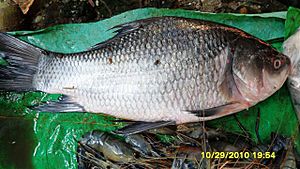
About 350 types of fish live in the Ganges River system. A study from 2007–2009 found 143 fish species in the Ganges basin itself. The most common types are carp, catfish, and perciform fish.
The Ganges basin supports major fisheries, but the number of fish has gone down in recent years. Some fish caught include catla, golden mahseer, rohu, and walking catfish.
About 30 fish species in the Ganges basin are now threatened. The main problems are too much fishing, pollution, taking too much water, and new species. The critically endangered Ganges shark is one of these threatened species. Dams can also stop fish from moving between different parts of the river.
Crocodiles and Turtles
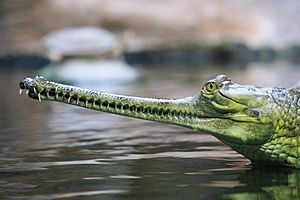
The Ganges River is home to the gharial and mugger crocodile. The Ganges Delta is also home to the saltwater crocodile. Many types of aquatic turtles live in the Ganges basin, including the northern river terrapin and red-crowned roofed turtle. Most of these turtles are seriously threatened.
The Ganges River Dolphin
The most famous animal in the Ganges is the Ganges river dolphin. This freshwater dolphin was recently named India's national aquatic animal.
These dolphins used to live in large groups in the Ganges and Brahmaputra rivers. However, their numbers have dropped a lot because of pollution and dam building. Their population has decreased by 75% in the last 15 years. They have even disappeared from the main rivers that flow into the Ganges. A survey by the World Wide Fund for Nature found only about 3,000 left in both river systems.
The Ganges river dolphin is one of only five true freshwater dolphins in the world. This means they live only in freshwater rivers and lakes.
How Climate Change Affects the Ganges
The Tibetan Plateau holds a huge amount of ice, the third largest in the world. Experts say that the glaciers in the Himalayas are melting faster than anywhere else. This could cause floods and mudslides in the short term. However, in the long term, these glaciers are vital for Asian rivers like the Indus and the Ganges. If they disappear, the water supply in these regions will be in danger.
Pollution and Environmental Concerns
The Ganges River has very high levels of pollution. This is caused by the many people who live near the river. Sewage from cities, waste from industries, and religious offerings wrapped in plastic all add pollutants to the river. The problem is made worse because many people rely on the river daily for bathing, washing clothes, and cooking.
The World Bank estimates that health problems from water pollution in India cost about three percent of India's economy. It is also thought that 80% of all illnesses and one-third of deaths in India are caused by diseases from polluted water.
Images for kids
-
A sailboat on the main part of the Ganges in Bangladesh, the Padma River.
-
The Ganges Delta in a 2020 satellite image.
-
Descent of Ganga, painting by Raja Ravi Varma c. 1910.
-
Women and children at a bathing ghat on the Ganges in Banares (Varanasi), 1885.
-
A procession of Akharas marching over a makeshift bridge over the Ganges River during Kumbh Mela at Allahabad, 2001.
See also
 In Spanish: Ganges para niños
In Spanish: Ganges para niños


